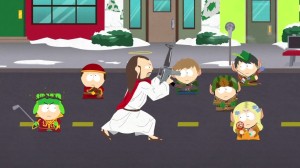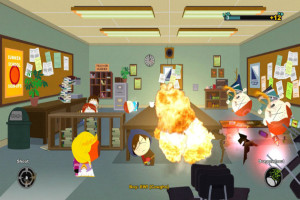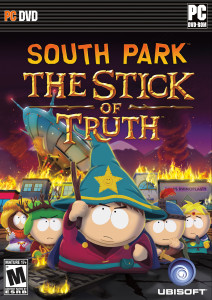Developed jointly by Obsidian Entertainment and South Park Digital Studios, South Park: The Stick of Truth is the sixth game, and first RPG, based on the long-running TV series. The development for The Stick of Truth was hindered by a number of delays, leading to many fans wondering if the game would end up following in the footsteps of the canceled Game Boy Color title. After surviving delays and a publisher change, is The Stick of Truth the South Park game fans have been waiting for?
The Stick of Truth puts players in the shoes of a kid, dubbed “Douchebag” by Cartman, that has just moved to South Park to escape his past. At the urging of his parents, Douchebag sets out to meet friends in his new hometown and is quickly befriended by Butters. Butters informs Douchebag that the local boys are locked in an epic role-playing fantasy game that pits humans versus elves in a battle for the Stick of Truth, an item of unstoppable power. Butters takes Douchebag to the Kingdom of Kupa Keep where he meets the Grand Wizard of the humans, Cartman. The humans are in possession of the Stick of Truth, but that quickly changes when the elves launch a surprise attack on Kupa Keep and take the Stick. The loss of his Kingdom’s treasure triggers Cartman to send Douchebag on a quest to bring reinforcements in an attempt to retrieve the invaluable Stick from the elves.
Receiving this quest also serves as the end of the brief tutorial for the game and opens up much of the town for exploring. The Stick of Truth gives long-time fans of the show the first true map of South Park, and it is hard to resist exploring every inch available. The town is full of areas that are more than familiar to fans, and each building is loaded with various references to episodes from the show. Exploring the various areas of town also allows players to take on side-quests and find treasure to add to their limitless inventory. Besides equipment and other items, the town of South Park also has plenty of citizens just waiting to add Douchebag as a friend on Facebook.

Summons in The Stick of Truth, like machine-gun-wielding Jesus are powerful, but can only be used once per day.
The most impressive aspect of The Stick of Truth is how well it mirrors the visual presentation of the television show. Moving around the town and the battle animations look great and stay true to animations from the show, but the real beauty is in the cutscenes. The cutscenes look like they were lifted straight out of an episode of the show and plopped into the game, a feat that really helps The Stick of Truth feel like a classic episode of the show. Of course, the show’s visuals are only part of the experience and thankfully Matt Stone and Trey Parker lent their vocal talents for many of the characters in the game. Although the music in The Stick of Truth is pretty bland, the various one-liners are more interesting and worthwhile than any music that could have fit in the game.
The visuals and voices in The Stick of Truth certainly are impressive, but they pale in comparison to the writing of Matt Stone and Trey Parker. Although they are usually more recognized for their vulgarity, Stone and Parker are adept satirists and their skills are on full display in TSoT. Stone and Parker use their first dive into the RPG genre as a way poke fun at various clichés found in it. For example, Douchebag is a silent protagonist, yet that does not stop other characters from asking him questions only to have him stand there without uttering a peep. Of course, no South Park experience would be complete without copious amounts of vulgarity, but The Stick of Truth takes it to the next level. Sure, there is the typical elementary school humor that comes with the license (Like using mana to power Douchebag’s magic of choice: farts), but Stone and Parker used The Stick of Truth to push the bar as far as they possibly could without getting the dreaded “Adults Only” rating.
While playing through The Stick of Truth, gamers will likely be strongly reminded of the first two games in the Paper Mario series, and not just because of the construction-paper graphics. Battles in SP:TSoT are fought between Douchebag and one partner against multiple enemies. Attacks use a timing mechanic that is similar to Paper Mario, but The Stick of Truth punishes players more for bad timing. Like Paper Mario, players are able to use an item or certain abilities before issuing an attack command for either Douchebag or his partner. Battles award the player with experience points, and the bodies of the vanquished foes can be looted for money and items. Once outside of battle, gamers will find that certain parts of the town can only be reached after learning new abilities.

Douchebag’s farts can ignite flames in the environment to incapacitate enemies without entering battle.
Although The Stick of Truth has many good things going for it, it is not without its fair share of flaws. Early in the game, players are given the choice to play as one of four classes: Fighter, Mage, Thief, or Jew. Equipment is not limited to the specific classes meaning the only difference between them is the set of abilities they obtain. This would not be as much of a problem if battles required a decent amount of strategy, but most battles can be easily conquered merely by using Douchebag’s most powerful attacks. Stat-replenishing items are more than plentiful and the party’s HP and PP are refilled and the end of every battle, making all-out attack strategies even more viable.
South Park: The Stick of Truth is the South Park game that fans of the series have always wanted. Unfortunately, the show’s fans are the only people that this game will appeal to. Besides the crude and vulgar humor that South Park is known for, TSoT‘s dizzying amount of fan-service will make much of the game feel like a series of inside jokes to anybody that has not watched the show religiously for the past seventeen years. Although it is a fantastic piece of fan-service, the low difficulty and short completion time will leave gamers wanting more. Despite its flaws, The Stick of Truth is a great game, even if it is only for one specific audience.
